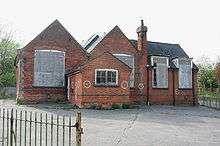Pulham St Mary
| Pulham St Mary | |
 St Mary's Church, Pulham St Mary |
|
 Pulham St Mary |
|
| Area | 12.26 km2 (4.73 sq mi) |
|---|---|
| Population | 892 |
| – density | 73/km2 (190/sq mi) |
| OS grid reference | TM212851 |
| Civil parish | Pulham St Mary |
| District | South Norfolk |
| Shire county | Norfolk |
| Region | East |
| Country | England |
| Sovereign state | United Kingdom |
| Post town | DISS |
| Postcode district | IP21 |
| Police | Norfolk |
| Fire | Norfolk |
| Ambulance | East of England |
| EU Parliament | East of England |
Coordinates: 52°25′12″N 1°15′11″E / 52.420°N 1.253°E
Pulham St Mary is a village in Norfolk, approximately 7 miles (11 km) east of Diss and 18 miles (29 km) south of Norwich. It covers an area of 12.26 km2 (4.73 sq mi) and had a population of 866 in 365 households as of the 2001 census, the population increasing to 892 at the 2011 Census.[1]
It is a small village and part of "The Pulhams" which also includes Pulham Market. The church, dedicated to St. Mary the Virgin, is believed to date from around 1258.
The name Pulham is thought to mean the farmhouse or enclosure by the pools or streams. The earliest recorded spelling is Polleham. The Romans may have had a settlement in Pulham St Mary as pieces of Roman tile, coin and oyster shells have been found in the area.
The village was well known in medieval times as a centre for hat-making, and the ancient Guild of St James the Lesser established the Guild Chapel, now in the centre of the village, as part of Pennoyer's school.
Pulham St Mary railway station was a stop on the Waveney Valley Line which closed in 1953.
The Pennoyer Centre
In 1670 William Pennoyer, a puritan merchant, left money to pay for a schoolmaster to teach poor children in the village.[2] (Pennoyer also left money to establish a scholarship at Harvard University in the USA, which remains in place today.)

The school was significantly expanded in the Victorian period. When the school finally closed in 1988, it was the longest-running free elementary school in the country. Most primary-age children in the village now attend the school in neighbouring Pulham Market, and a cycle path built for this purpose runs adjacent to the road connecting the two villages.
The Victorian frontage of the building concealed a listed medieval Guild Chapel dating from 1401, making it an expensive proposition for renovation and alternative use. Pennoyer's thus lay unused for almost two decades. In 2006, however, the building was entered in the third series of the BBC's Restoration Village programme in an attempt to secure the necessary funds to transform the building into a new village centre.
Although Pennoyer's School did not make the final of Restoration Village, the project remained on track, receiving almost £1m in funding from the Heritage Lottery Fund and £210,000 from Norfolk's Investing in Communities programme. Construction work began in February 2009, and The Pennoyer Centre, complete with a 21st Century extension, and new facilities such a cafe and internet suite, opened in July 2010 for education, business, social and recreational use.
RNAS Pulham and the "Pulham Pigs"
In 1912 under conditions of secrecy a large base, RNAS Pulham, was constructed for the operation of airships.[3] The airships were locally given the nickname of "Pulham Pigs". RNAS Pulham operated as a Royal Navy base until 1918 when it was transferred to the new Royal Air Force. In 1917 two large steel-framed sheds were erected and in 1919 a 120-foot (37 m)-high mooring mast joined them. Following its historic both-way Atlantic crossing the R34 returned to Pulham Market. The large rigid airships R33, R36 and R38 also visited. Its airship hangar was dismantled in 1928 and re-erected at Cardington. In the early 1920s there was a radio Direction finding station was located here, that helped give accurate position reports to aircraft operating into Croydon airport. The base became disused in the early 1930s after the crash of the R101 when all work stopped in Britain on airships, although it continued as an RAF property until 1958. During World War II it was a dump for crashed aircraft from all over the east of England; parts were salvaged for reuse. Munitions testing was also conducted on the site.
St Mary the Virgin
The village church is of flint construction with parts that date back to the thirteenth century. The church is dedicated to St Mary the Virgin, which gives the village the St Mary in its name.
Notes
External links
| Wikimedia Commons has media related to Pulham St Mary. |
- Pennoyer's Village Centre site including Pulham St Mary local & airship history
- Restoration Village project
- Pulham St Mary Parish Council